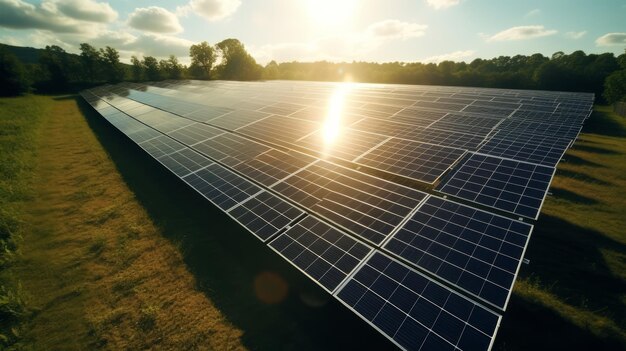
Smart Grids: Revolutionizing Energy Distribution – A Beginner’s Guide to the Future of Power
Imagine a world where your electricity knows exactly what it’s doing, where it’s needed most, and how to get there efficiently, even when things go wrong. That’s the promise of the Smart Grid – a revolutionary leap forward from the century-old electrical infrastructure we currently rely on.
For decades, our energy system has operated largely on a one-way street: power plants generate electricity, and it’s pushed out to homes and businesses. This traditional grid, while a marvel of engineering for its time, is like a "dumb" phone in an age of smartphones. It lacks real-time information, two-way communication, and the intelligence to adapt to our rapidly changing energy needs.
But change is here. Smart Grids are transforming how we generate, transmit, distribute, and consume electricity, paving the way for a more reliable, efficient, sustainable, and resilient energy future. If you’ve ever wondered how your power might become smarter, more responsive, and even help the planet, you’re in the right place.
What Exactly is a Smart Grid?
At its simplest, a Smart Grid is an electrical grid that uses modern digital technology to improve the efficiency, reliability, and sustainability of electricity services. Think of it as upgrading our entire power system with a high-speed, intelligent communication network, sensors, computers, and automated controls.
Instead of just pushing electricity one way, a Smart Grid allows for two-way communication between utilities and consumers, and across all parts of the grid itself. This constant flow of information enables real-time monitoring, analysis, and control, making the entire system much more dynamic and responsive.
Key Differences from the Traditional Grid:
- Traditional Grid: One-way flow of electricity, limited information, manual operations, reactive to problems.
- Smart Grid: Two-way flow of electricity and information, real-time data, automated control, proactive problem-solving.
How Does a Smart Grid Work? (The Digital Nervous System)
To understand how a Smart Grid operates, imagine it as a sophisticated digital nervous system for our energy network.
-
Sensors Everywhere: Just like nerves in your body, thousands of sensors are deployed across the grid – in power plants, transmission lines, substations, and even at your home (via smart meters). These sensors continuously collect data on voltage, current, temperature, power quality, and more.
-
Smart Meters: These aren’t your old spinning-dial meters. Smart meters digitally record energy consumption in detail (e.g., every 15 minutes) and can securely send that data directly to the utility. They can also receive information, allowing for things like remote connect/disconnect or pricing signals.
-
Communication Network: All this data needs to travel. Smart Grids use a secure, high-speed communication network (like fiber optics, wireless, or power line communication) to transmit information instantly between all components of the grid.
-
Data Analytics & AI: Once the data arrives at a central control system, powerful computers, often leveraging Artificial Intelligence (AI) and machine learning, analyze it in real-time. They identify patterns, predict potential issues, and determine the most efficient ways to manage power flow.
-
Automated Control: Based on the analysis, the system can automatically make adjustments. This could mean rerouting power around a fault, adjusting voltage levels, or even communicating with smart appliances in your home to reduce demand during peak times.
This constant feedback loop allows the Smart Grid to be incredibly agile and responsive, a stark contrast to the static nature of the old system.
Key Features and Technologies of Smart Grids
The "smart" in Smart Grid comes from the integration of various innovative technologies:
- Smart Meters: As mentioned, these are crucial for real-time data on consumption and enabling two-way communication between consumers and the utility. They are the gateway for consumer participation.
- Advanced Sensors & Phasor Measurement Units (PMUs): These devices provide incredibly precise, synchronized measurements of electricity flow across the grid. This detailed information allows operators to detect disturbances and instability almost instantly.
- Two-Way Communication Infrastructure: This is the backbone, allowing data to flow from meters to utilities, from substations to control centers, and even back to grid devices for automated commands.
- Automated Distribution Systems (Self-Healing Grids): When a fault occurs (like a tree falling on a power line), smart grid technology can automatically detect the problem, isolate the affected section, and reroute power around it to minimize outages. This "self-healing" capability significantly reduces downtime.
- Demand Response Programs: These programs encourage consumers (and businesses) to reduce or shift their electricity use during peak demand periods. Utilities can offer incentives or special pricing for participating, helping to balance the grid and avoid costly infrastructure upgrades.
- Integration of Renewable Energy Sources: Solar and wind power are intermittent – they don’t produce electricity consistently. Smart Grids are essential for managing these fluctuations, efficiently integrating renewable energy into the main grid, and storing excess power when available.
- Electric Vehicle (EV) Integration: As EVs become more common, Smart Grids can manage their charging to avoid overwhelming the system. They can even potentially use EV batteries as temporary storage or power sources for the grid (Vehicle-to-Grid or V2G).
- Microgrids: These are smaller, localized energy grids that can operate independently from the main grid if needed (e.g., during a blackout). They often combine local generation (like solar panels) with battery storage and smart controls, providing enhanced reliability for critical facilities or communities.
The Benefits of Smart Grids: Why We Need Them
The advantages of transitioning to a Smart Grid are numerous and impactful:
- Increased Efficiency:
- Reduces transmission losses by optimizing power flow.
- Helps balance supply and demand, preventing wasted energy.
- Leads to more efficient use of existing infrastructure.
- Enhanced Reliability and Resilience:
- "Self-healing" capabilities lead to fewer and shorter power outages.
- Better detection and isolation of faults.
- Improved ability to withstand and recover from severe weather events or cyberattacks.
- Better Renewable Energy Integration:
- Facilitates the seamless incorporation of solar, wind, and other intermittent renewable sources.
- Manages the variable nature of renewables to ensure grid stability.
- Empowered Consumers:
- Real-time energy usage data allows consumers to make informed decisions about their consumption.
- Demand response programs can help consumers save money on their electricity bills.
- Opens the door for consumers to generate their own power (e.g., rooftop solar) and sell excess back to the grid.
- Cost Savings:
- Reduced operational costs for utilities due to automation and efficiency.
- Potential for lower electricity bills for consumers through smarter usage.
- Avoids costly investments in building new power plants by better managing existing capacity.
- Environmental Benefits:
- Lower carbon emissions due to increased integration of renewables and reduced energy waste.
- More efficient use of resources.
Challenges and Considerations
While the benefits are compelling, building a fully integrated Smart Grid is a massive undertaking with its own set of challenges:
- Cybersecurity: A highly connected, digital grid is also a potential target for cyberattacks. Robust security measures are paramount to protect critical infrastructure from disruption.
- Cost and Investment: The transition requires significant investment in new infrastructure, software, and training. This cost must be managed and justified to regulators and consumers.
- Regulatory Hurdles: Existing energy regulations were designed for the traditional grid. New policies and frameworks are needed to support Smart Grid technologies and business models.
- Data Privacy: With vast amounts of data being collected (especially from smart meters), ensuring consumer privacy and data security is a critical concern.
- Interoperability: Different manufacturers produce different Smart Grid components. Ensuring all these diverse systems can communicate and work together seamlessly is a complex technical challenge.
- Public Acceptance: Educating consumers about the benefits of Smart Grids and addressing concerns about privacy or perceived loss of control is essential for successful adoption.
The Future of Energy with Smart Grids
The Smart Grid isn’t just a concept; it’s a rapidly evolving reality. As technology advances, we can expect even more sophisticated capabilities:
- Enhanced AI and Machine Learning: Deeper insights and predictive analytics will make the grid even more proactive and efficient.
- Widespread Microgrids: More communities and critical facilities will adopt localized grids for enhanced resilience.
- Integration with Smart Homes and IoT: Your smart thermostat, electric vehicle, and even major appliances will communicate seamlessly with the grid for optimized energy use.
- Decentralized Energy Generation: More power will come from diverse, smaller sources like rooftop solar and community wind farms, all managed intelligently by the Smart Grid.
- Energy Storage Solutions: Advanced battery storage and other energy storage technologies will become integral to balancing supply and demand, especially with intermittent renewables.
Conclusion
The Smart Grid represents a fundamental shift in how we manage our most vital resource: electricity. It’s moving us from a century-old, one-way system to a dynamic, intelligent, and interconnected network that can adapt to the demands of the 21st century.
While challenges remain, the undeniable benefits of increased efficiency, reliability, sustainability, and consumer empowerment make the Smart Grid not just an option, but a necessity. It’s the digital backbone for a cleaner, more resilient, and more responsive energy future for us all. The revolution in energy distribution is well underway, and the Smart Grid is leading the charge.



Post Comment